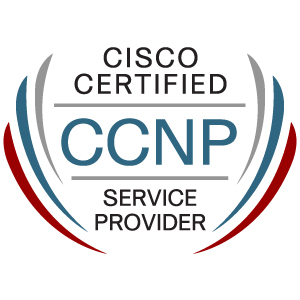
CCNP Service Provider
Course Content
This Instructor Lead Training course is #1 of 4. It will prepare students for the SPROUTE exam required for the new CCNP-SP Certification. This certifictation is designed to prepare students to work at the Professional level in a Service Provider environment. The SPROUTE course is designed to provide service provider professionals with information on the use of advanced routing in implementing scalability for Cisco routers that are connected to LANs and WANs. The goal is to train professionals to dramatically increase the number of routers and sites using these techniques instead of redesigning the network when additional sites or wiring configurations are added. The SPROUTE training reinforces the instruction by providing students with hands-on labs to ensure they thoroughly understand how to implement advanced routing within their networks. The course also includes classroom activities with remote labs that are useful to gain practical skills on deploying Cisco IOS / IOS XE and Cisco IOS XR features to operate and support service provider network.
Course Objectives
The goal of the course is to train service provider network professionals on the techniques to plan, implement, and monitor a scalable IP routing.
Course Outline
Module 1: Service Provider Routing
- Lesson 1-1: Understanding Service Provider Routing Protocols
Module 2: Implement OSPF in the Service Provider Network
- Lesson 2-1: Introducing OSPF Routing
- Lesson 2-2: OSPF Operation
- Lesson 2-3: Implementing OSPF Routing
- Lab 2-1: Implementing OSPF Routing
- Lesson 2-4: Implementing OSPF Special Area Types
- Lab 2-2: Implementing OSPF Special Area Types
Module 3: Implement Integrated IS-IS in the Service Provider Network
- Lesson 3-1: Introducing IS-IS Routing
- Lesson 3-2: Implementing integrated IS-IS routing
- Lab 3-1: Implementing integrated IS-IS routing
Module 4: Implement BGP in the Service Provider Network
- Lesson 4-1: Introducing BGP Routing
- Lesson 4-2: Implementing Basic BGP routing
- Lab 4-1: Implementing Basic BGP routing
Module 5: Routing Protocol Tools and Route Manipulation
- Lesson 5-1: Introducing Routing Protocol Tools
- Lesson 5-2: Implementing Route Redistribution
- Lab 5-1: Implementing Route Redistribution
- Lesson 5-3: Influencing BGP Route Selection
- Lab 5-2: Influencing BGP Route Selection
Prerequisites
The knowledge and skills that a learner must have before attending this course are as follows:
- Basic computer literacy
- Basic Microsoft Windows navigation skills
- Basic Internet usage skills
- Basic knowledge of networking concepts
- Basic knowledge of Cisco IOS / IOS XE and Cisco IOS XR software configuration
- Skills and knowledge equivalent to those learned in Building Cisco Service Provider Next-Generation Networks, Part 1 (SPNGN1) course.
- Skills and knowledge equivalent to those learned in Building Cisco Service Provider Next-Generation Networks, Part 2 (SPNGN2) course.
- Skills and knowledge equivalent to those learned in Deploying Cisco Service Provider Network Routing (SPROUTE) course.
Course Content
This Instructor Lead Training course is #2 of 4. It will prepare students for the SPADVROUTE exam required for the new CCNP-SP Certification. This certifictation is designed to prepare students to work at the Professional level in a Service Provider environment.
Course Objectives
Upon completing this course, the learner will be able to meet these overall objectives:
- Configure the service provider network to support multiple BGP connections with customers and other autonomous systems.
- Describe common routing and addressing scalability issues in service provider network.
- Describe available BGP tools and features to secure and optimize the BGP routing protocol in a service provider environment.
- Introduce IP multicast services and the technologies present in IP multicasting.
- Introduce PIM-SM as the most current scalable IP multicast routing protocol.
- Describe service provider IPv6 transition implementations.
Course Outline
Module 1: Service Provider Connectivity with BGP
- Lesson 1: Defining Customer-to-Provider Connectivity Requirements
- Lesson 2: Connecting a Customer to Service Provider
Module 2: Scale Service Provider Network
- Lesson 1: Scaling BGP in Service Provider Networks
- Lesson 2: Introducing BGP Route Reflectors and Confederations
Module 3: Secure and Optimize BGP
- Lesson 1: Implementing Advanced BGP Operations
- Lesson 2: Improving BGP Convergence
- Lesson 3: Improving BGP Configuration Scalability
Module 4: Multicast Overview
- Lesson 1: Introducing IP Multicast
- Lesson 2: Defining Multicast Distribution Trees and Forwarding
- Lesson 3: Multicast on the LAN
- Lesson 4: Populating Mroute Table
Module 5: Intra- and Inter-Domain Multicast Routing
- Lesson 1: Introducing PIM-SM Protocol
- Lesson 2: Implementing PIM-SM Enhancements
- Lesson 3: Implementing Interdomain IP Multicast
- Lesson 4: Identifying Rendezvous Point Distribution Solutions
Module 6: Service Provider IPv6 Transition Implementations
- Lesson 1: Introducing IPv6 Services
- Lesson 2: Defining IPv6 Transition Mechanisms
- Lesson 3: Deploying IPv6 in the Service Provider Network
Prerequisites
The knowledge and skills that a learner must have before attending this course are as follows:
- Intermediate to advanced knowledge of Cisco IOS / IOS XE and Cisco IOS XR software configuration.
Skills and knowledge equivalent to those learned in:
- Building Cisco Service Provider Next-Generation Networks (SPNGN1), Part 1 course.
- Building Cisco Service Provider Next-Generation Networks (SPNGN2) Part 2 course.
- Deploying Cisco Service Provider Network Routing (SPROUTE) course.
- Deploying Cisco Service Provider Advanced Network Routing (SPADVROUTE) course.
Course Content
This Instructor Lead Training course is #3 of 4. It will prepare students for the SPCORE exam required for the new CCNP-SP Certification. This certifictation is designed to prepare students to work at the Professional level in a Service Provider environment.
Course Objectives
Upon completing this course, the learner will be able to meet these overall objectives:
- Describe the features of MPLS, and how MPLS labels are assigned and distributed.
- Discuss the requirement for traffic engineering in modern networks that must attain optimal resource utilization.
- Introduce the concept of QoS and explain the need to implement QoS.
- Classify and mark network traffic to implement an administrative policy requiring QoS.
- Introduce different Cisco QoS queuing mechanisms used to manage network congestion.
- Introduce the concept of traffic policing and shaping, including token bucket, dual token bucket, and dual-rate policing.
Course Outline
Module 1: Multiprotocol Label Switching
- Lesson 1: Introducing MPLS
- Lesson 2: Running Label Distribution Protocol
- Lesson 3: Implementing MPLS in the Service Provider Core
Module 2: MPLS Traffic Engineering
- Lesson 1: Introducing MPLS Traffic Engineering Components
- Lesson 2: Running MPLS Traffic Engineering
- Lesson 3: Implementing MPLS TE
- Lesson 4: Protecting MPLS TE Traffic
Module 3: QoS in the Service Provider Network
- Lesson 1: Understanding QoS
- Lesson 2: Implementing Cisco QoS and QoS Mechanisms
- Lesson 3: Implementing MPLS Support for QoS
Module 4: QOS Classification and Marking
- Lesson 1: Understanding Classification and Marking
- Lesson 2: Using Modular QoS CLI
- Lesson 3: Implementing Advanced QoS Techniques
Module 5: QoS Congestion Management and Avoidance
- Lesson 1: Managing Congestion
- Lesson 2: Implementing Congestion Avoidance
Module 6: QoS Traffic Policing and Shaping
- Lesson 1: Understanding Traffic Policing and Shaping
- Lesson 2: Implementing Traffic Policing
- Lesson 3: Implementing Traffic Shaping
Prerequisites
The knowledge and skills that a learner must have before attending this course are as follows:
- Intermediate to advanced knowledge of Cisco IOS / IOS XE and Cisco IOS XR software configuration.
Skills and knowledge equivalent to those learned in:
- Deploying Cisco Service Provider Network Routing (SPROUTE) 1.0 course.
- Deploying Cisco Service Provider Advanced Network Routing (SPADVROUTE) 1.0 course.
- Implementing Cisco Service Provider Next-Generation Core Network Services (SPCORE) 1.0 course.
Course Content
This Instructor Lead Training course is #4 of 4. It will prepare students for the SPEDGE exam required for the new CCNP-SP Certification. This certifictation is designed to prepare students to work at the Professional level in a Service Provider environment.
Course Objectives
Upon completing this course, the learner will be able to meet these overall objectives:
- Introduce VPN technologies used in the service provider environment and the MPLS VPN peer-to-peer architecture.
- Describe implementation steps needed to provide MPLS Layer 3 VPN service in the service provider network.
- Describe how the MPLS Layer 3 VPN model can be used to implement managed services and Internet access.
- Describe Layer 2 VPNs and Ethernet services.
Course Outline
Module 1: VPN Technologies
- Lesson 1: Introducing Virtual Private Networks
- Lesson 2: Introduction to MPLS VPN
Module 2: MPLS Layer 3 VPN
- Lesson 1: Implementing MPLS Layer 3 VPN Backbone
- Lesson 2: Connecting Customers using Simple Routing Protocols
- Lesson 3: Connecting Customers using BGP or OSPF
- Lesson 4: IPV6 and MPLSModule 3: Complex MPLS Layer 3 VPNs
- Lesson 1: Implementing Complex MPLS Layer 3 VPNs
- Lesson 2: Implementing Internet Access and MPLS Layer 3 VPNs
- Lesson 3: Introduction to MPLS Inter-Domain SolutionsModule 4: Layer 2 VPNs and Ethernet Services 1
- Lesson 1: Introducing Layer 2 VPNs 2
- Lesson 2: Introducing Any Transport over MPLS
- Lesson 3: Implementing VPLS
